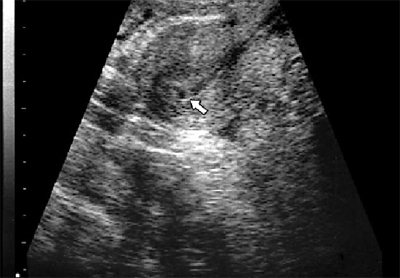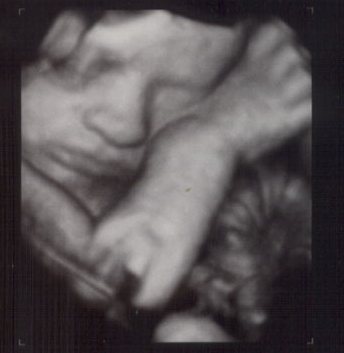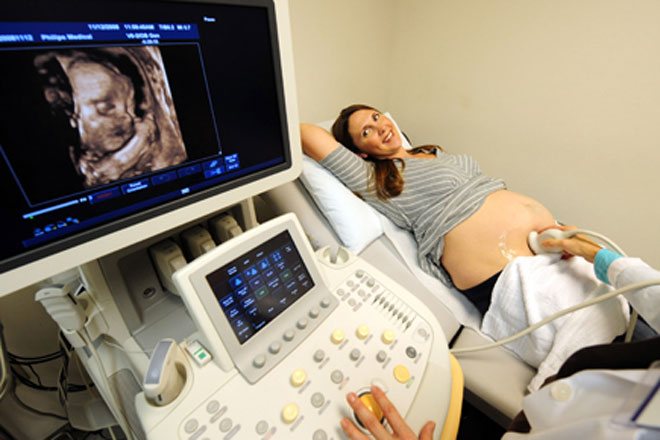The sincere joy of parents who learn about a successful conception is always associated with an irresistible desire to find out who should be born - a son or a daughter. And such an opportunity exists in a variety of ways. In addition, it is important to understand at what month you can find out the sex of the child. To do this, it is worth getting acquainted directly with the process of formation of the reproductive system of the embryo, finding out the timing and order of its important stages.
At what month can you find out the gender of the baby?
During fertilization, a new organism formed by a male and a female cell has 46 chromosomes, despite the fact that the sperm carries Y and X chromosomes, while the female cell only has X. At about 6 weeks, the process of formation of the gonads occurs. The presence of a male chromosome and HY -antigen determines the male sex of the embryo, but if the antigen is absent, then the embryo will be female.
The gonads are formed at 8-9 weeks under the influence of hormones and depend on their level. With a significant predominance of testosterone, the male sex is formed. Only after this does the formation of the genital organs begin.
Gender Determination Time
Modern ultrasound machines today are much more powerful and functional than before, but they also have their limitations.
The sex of the unborn child is determined immediately after conception, but no device can record it at this time.
Moreover, even for pregnancy to be detected, 5–10 days must pass after the delay; before this period, it will be almost impossible to determine the presence of an embryo.
Photo:

If we talk about the sex of the child, the formation of the genital organs, as well as other important systems of the body, also begins almost immediately after conception, but in the first trimester it will be difficult to determine exactly who will be born.
The first planned ultrasound is usually performed at 10–14 weeks of pregnancy, and at this time, theoretically, the gender of the unborn baby can be seen, as well as how many children are expected.
However, in order to see the sex, several factors must coincide: ultrasound must be performed on very high-quality equipment, the doctor must be qualified and, most importantly, the embryo must take the correct position in which the rudiments of the genital organs will be visible.
But even if all these conditions coincide, it will be difficult to find out how accurately the sex is established at such an early stage, since the male and female genital organs of the embryo look almost identical during this period.
Often, for example, doctors confuse a girl with a boy during an ultrasound due to swelling of the labia, which goes away on its own at a later date and does not require treatment.
In the first weeks, you can determine exactly what gender the fetus is using another procedure - chorionic villus biopsy.
Video:
This method determines gender with 100% probability already at 6–8 weeks, however, without certain indications, a chorionic villus biopsy is not performed, as it can lead to miscarriage.
Most often, this procedure is required to identify serious genetic abnormalities, and, unlike ultrasound, it is very painful.
If at an early stage - 12 - 14 weeks - it is not possible to determine the sex of the child, then you will have to wait for the second planned ultrasound: it, as a rule, will already be able to determine with a high probability who will soon be born.
How much time will pass before the second examination is determined individually, but usually the examination is carried out at 18–22 weeks of pregnancy, and at this time the external and internal organs are already completing their formation, so it will not be difficult for an experienced doctor to distinguish male genital organs from female ones.
READ We monitor the development by photo of the size of the fetus on ultrasound by the 11th week of pregnancy
Difficulty can arise only when the position of the fetus does not allow you to see the whole picture, but today this is easily solved with the help of 3D and 4D studies, which provide a three-dimensional image of the unborn baby.
They will not only show who will be born, but will also determine exactly how many children should be born.
Photo:

Medical prognosis
The most reliable gender recognition is achieved through ultrasound; it gives a true result in 90 cases out of a hundred, but it is worth understanding that the procedure must be carried out when the external organs are already formed. In fact, the examination is necessary in order to make sure that the baby is in a healthy condition and is developing normally. This helps prevent various pathologies in the fetus and mother, therefore the main indications for instrumental diagnostics are:
- assessment of the possibility of hereditary abnormalities;
- recognizing the potential risk of miscarriage;
- study of the baby's presentation and its condition;
- exclusion of congenital pathologies.
However, at what time can you find out the sex of a child using instrumental diagnostics? Despite the fact that at the beginning of the second month the transformation of the genital tubercle into the labia and penis already occurs, it is difficult to accurately understand from an ultrasound who is conceived, since the picture is unclear. Doctors warn that it is best to find out the gender using ultrasound no earlier than the 21st obstetric week, when not only the formation of the genital organs is completed, but the conditioned reflexes of a practically viable baby are manifested.
In addition, modern technologies, such as 3D ultrasound, make it possible, in addition, to take a photograph of the baby and examine the features of his face. For this purpose, the study is carried out in the second half of the gestation period.
An experienced specialist can identify the baby’s identity based on additional signs that accompany the development of his genitals. So, with the synthesis of hormones in the middle of the third month, folds already appear, which in the future form the penis or clitoris and labia.

This is done:
- By analyzing the angle between the genital tubercle and the back of the fetus - if the angle is more than 30 degrees, a boy is subsequently born, if the figure is less than 30 degrees, a girl is born.
- By assessing the location of the placenta. If it is on the left side of the uterine cavity, the child is a girl; if it is on the right side, it means male.
- Auxiliary parameters are the shape of the skull; in a boy it is closer to square, while in a girl it is more smooth and rounded.
It is equally important to know at what month you can find out the gender of the child using DNA analysis, that is, by blood. For medical reasons, such testing, which has an accuracy of about 99%, is prescribed when there is a suspicion of hereditary diseases - Klinefelter and Shereshevsky-Turner syndrome. The study is based on the fact that there is a certain percentage of fetal DNA fragments in the mother’s blood, but it is not advisable to conduct it before 7 weeks.
Also, identifying the sex of children is carried out through chorionic biopsy - samples of embryonic tissue (chorionic villi) are taken, and then they are examined, subjected to cytogenetic, biochemical and molecular analysis. This is a 100%, but far from safe method, and under unfavorable conditions it can result in termination of pregnancy.
Another method of determination is to study the biochemical composition of amniotic fluid. Such an examination can be carried out 4 months after the start of pregnancy. It is believed, not without reason, that this option gives a 100% reliable result.
When will an ultrasound tell parents the sex of the baby?
Throughout a woman’s pregnancy, the ultrasound procedure is performed three times. In rare cases, the doctor prescribes additional examinations to monitor the health of the baby and mother. The main purpose of this ultrasound process is to determine the development parameters, condition and size of the fetus, but you can also find out the sex of the child, which is of great concern to future parents.
Boy or girl - this is determined by male sperm. If the X chromosomes are the main ones, then you should expect the birth of a girl, and if the Y chromosomes predominate, most likely a boy will be born. During pregnancy, the determination of this parameter depends primarily on the period. Standard procedures are carried out exactly in the prescribed weeks. The very first procedure at 12-13 weeks makes it possible to identify obvious developmental defects, but it is not yet possible to determine the sex of the unborn child. The state of the fetus at this moment is at the stage of already formed genital organs, but not every equipment is capable of accurately and clearly conveying their appearance.
The second ultrasound examination should be done at 22-24 weeks. Then the size of the fetus is already quite large and the baby feels great. At this moment, the anatomy of the little person is already formed and the sex of the child can be determined. During this period of pregnancy, important medical indicators are also determined, for example, size, heartbeat, level of development. They play a big role in assessing the condition of the woman and baby. The ultrasound method will show the position in which the fetus is located. It is possible to find out exactly who will be born, a girl or a boy, at this stage of pregnancy, but it all depends on exactly how the baby is lying. Parents may be disappointed if he turns into an awkward position and hides the right place.
The last mandatory ultrasound is performed at 32-34 weeks. It allows you to clarify the condition of the fetus, and also the method shows what gender of the unborn child you should expect if this was not visible in previous procedures. At this moment, extremely important data for the doctor is also obtained, for example, the weight of the fetus, the level and signs of development, what position the boy or girl is in, and other information.
Why do errors occur when determining gender?
When understanding how long it takes to determine the sex of a child, it is worth warning parents that difficulties can arise during any month of gestation. And sometimes, annoying mistakes happen.
Why does this happen:
- in some cases, the clitoris and labia of the female infant become swollen, making it look like an imitation of the penis;
- in a short period of up to three and a half months and with intrauterine growth retardation, diagnosing gender is difficult;
- The loops of the umbilical cord, as well as the fingers of the pens located in the crotch area during the study, can be taken as male differences;
- some positions of the fetus do not make it possible to see the baby’s gender characteristics;
- in the third trimester, the cause of errors may be the size of the baby and its close location in the uterus;
- errors are natural with pathologies and defects in the development of the external genitalia;
- Sometimes the detection of gender characteristics is hampered by the excess volume of amniotic (amniotic) fluid; the greater thickness of the mother’s peritoneal wall may also be to blame.
- sometimes incorrect identification is due to inaccurate measurements (when identification is made by the genital tubercle);
- The accuracy of recognition often depends on the qualifications of the doctor and his skills in working with diagnostic equipment.
At a later date, it can be more difficult to find out the sex of the baby, since the peculiarity of the child’s posture and its large size often become an obstacle to this. For the same reason, it is difficult to identify gender in multiple pregnancies.
At what stage of pregnancy can gender be determined?
So, at what time can you find out the gender of the child? The penis in boys begins to form only at the 11th week , so trying to see it earlier than the 13th week of pregnancy is pointless. But you should be prepared for the fact that at the next planned ultrasound at the 20th week the doctor will change his opinion to the opposite, since at the 13th week the fetus is still small and the picture is unclear. Thus, the optimal period for determining gender is 20-24 weeks of pregnancy, that is, approximately in the fifth month, and when exactly the “X-hour” comes will be determined by the accompanying doctor.
However, by the 18th week, an experienced doctor using a good device will not make a mistake, provided that the baby “allows” to see his gender, because very often babies cover themselves with the umbilical cord, arms, cross their legs and simply turn away. Therefore, before going for an ultrasound, it is recommended to eat chocolate - supposedly the child becomes active from the sugar entering the blood, which increases the chances of discerning his gender.
Modernly equipped clinics offer 3D ultrasound services . 3D allows you to see the baby in more detail and determine the gender more confidently.
Determining the sex of the unborn child and factors that create errors in research results
In which week is it most likely to find out the gender? From the 6th week, primary signs begin to form; they consist in the appearance of the genital tubercle, from which the system of external organs of the future person is subsequently formed. However, at this stage it is still very early to talk about whether the embryo belongs to one sex or another. Therefore, a planned ultrasound performed at 10-12 weeks does not provide an opportunity to fully examine the baby’s genitals.
Here we should immediately make a reservation that it is possible to determine the sex of the child at this stage. However, such research results have a huge error and their coincidence with the real picture is more random than reliable.
How many weeks can we talk about the accuracy of test results? The second planned ultrasound performed at 20-21 weeks of pregnancy will help to most reliably determine the gender of the unborn baby. By this time, all organs are already sufficiently formed and developed, which makes the results of similar studies the most reliable. Starting from 15-16 weeks, you can accurately find out the sex of the child. Moreover, the reliability of the results of such tests is at a significantly high level, 85-90%. The remaining 10-15% is an acceptable error, the occurrence of which may be due to the presence of certain factors that complicate research. These include the following conditions:
- location of the placenta along the anterior wall;
- maternal obesity;
- position of the child.
Gender of the child according to ultrasound
© vadimguzhva/Getty Images
One of the most accurate methods for determining the sex of your baby during pregnancy is an ultrasound, or ultrasonography, which uses high-frequency sound waves to create an image of your baby inside your uterus.
An ultrasound is not performed to determine the sex of the child, but to find out whether the child is developing correctly.
Depending on the length of your pregnancy and the position of the fetus, your doctor can tell you for sure whether you are carrying a boy or a girl.
How does a doctor determine the sex of a baby during an ultrasound examination?
Even in the early stages of pregnancy, from approximately 12-14 weeks, the so-called genital tubercle is noticeable in the embryo - this is the rudiment of the future genital organs. An experienced doctor with good equipment will be able to predict the sex of the baby already at this stage. To do this, the relationship between the tubercle and the back of the child is assessed. If the angle drawn through these parts is more than 30 degrees, then the specialist assumes a male fetus. If less than 30, you will most likely have a girl. But at this time, the accuracy of the forecast is far from ideal: no more than half of the “prophecies” come true.

From about the 20th week of intrauterine development, when the sex of the child can be determined more accurately by ultrasound, most couples ask the doctor a secret question. At this stage, the doctor evaluates the appearance of the genital organs of the unborn child, and not mathematical relationships. But you shouldn’t delay determining sex: a grown fetus easily hides its sexual characteristics, because he feels cramped in the uterus.
It is noteworthy that if a specialist promised you a girl, this will most likely turn out to be a mistake . The fact is that the descent of the testicles into the scrotum in all children occurs at different stages of intrauterine life, and sometimes even after childbirth. Therefore, the likelihood that the sex of the child will not be clearly determined on the screen of an ultrasound diagnostic device is higher.









